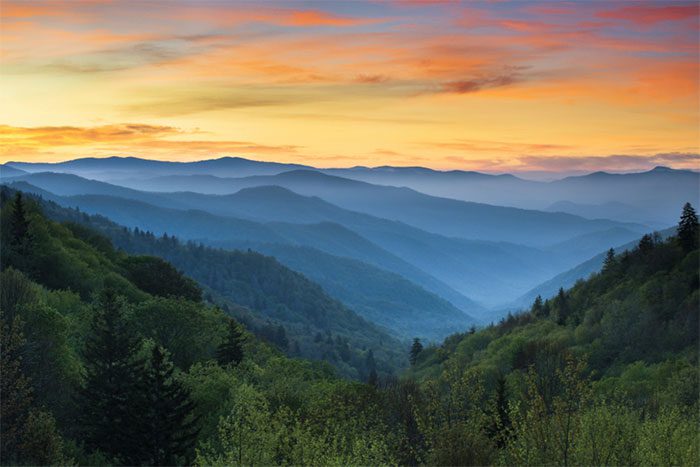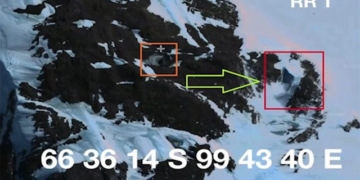Most of the mountains we see may appear ancient, but few know about their geological age. While some are merely “toddler” mountains, others belong to the “senior” age group.
According to the American Museum of Natural History in New York City, high mountain ranges like the Himalayas tend to be younger, while mountains with shorter peaks, such as the Appalachians, are generally older due to millennia of erosion.
Due to the ever-changing terrain of Earth, it is challenging to define this super-age, and it requires an understanding of how these peaks rise and fall over time.

Sunrise over Great Smoky Mountains National Park in Gatlinburg, Tennessee, part of the Appalachian Mountains.
The landscape today is characterized by actively growing mountain ranges and inactive ones that have undergone significant changes over billions of years. Jim Van Orman, a geochemist at Case Western Reserve University in Ohio, explains that this is why accurately determining the age of these peaks is difficult.
Most mountain ranges form due to tectonic plates, massive slabs of rock that float on the Earth’s mantle. When different tectonic plates interact over millions of years, entire mountain ranges can rise into the sky.
There are two main types of tectonic boundaries. At convergent boundaries, tectonic plates collide with each other. This collision often causes the lower-density plate to sink or slide beneath the other plate. Van Orman notes that this subducting crust can push land up and form gigantic mountain ranges, like the Himalayas, which includes Mount Everest. Conversely, divergent boundaries occur when tectonic plates pull apart. As the plates move away from each other, the crust stretches and thins like taffy. Hot magma rises to fill the gaps created, forming mountains and valleys similar to those found in the Basin and Range Province in the western United States and northwestern Mexico.
There are many nuances when it comes to the age of mountain ranges. For example, the Appalachian Mountains.
The range began to rise from a convergent boundary about 470 million years ago and continued to rise even higher around 270 million years ago when the continents that eventually became North America and Africa collided, according to the U.S. Geological Survey. Over the millions of years that followed, erosion reduced its original height. The mountains we know today are a result of a subsequent uplift that rejuvenated their elevation. This rise and fall in height—a characteristic feature of mountains—makes it challenging and subjective to label the true age of a range.
Van Orman told Live Science, “There is an age for the original rocks, but it wasn’t a mountain when it was eroded [or worn away] for a large part of its history. So, how old is it really?”
Although tracing the timeline of a mountain range is complex, geologists have tools to measure the age of mountain components depending on the type of rock. When igneous and metamorphic rocks form, they create minerals and radioactive isotopes, or variants of elements with different numbers of neutrons in their nuclei, which can be dated. For sedimentary rocks, researchers use clues trapped in rock layers, such as fossils or volcanic ash, to estimate the age of the rock. Van Orman notes that sediments eroded from mountains that end up in nearby basins can also be traced back to their high-altitude origins to determine their appropriate age.
From these measurements, geologists can establish a relative age range for various mountainous terrains on Earth. According to NASA’s Earth Observatory, in terms of older formations, the Makhonjwa Mountains in southern Africa, which rise only between 2,000 to 5,900 feet (600 to 1,800 meters), contain rocks that are 3.6 billion years old. Other ancient rocks that make up the continental core, referred to as “cratons”, may have once been part of mountain ranges and can be found in Greenland, Canada, Australia, and beyond.
Other mountain ranges have a more recent geological history; for example, those in the Basin and Range Province, such as the Snake Range, began to emerge about 30 million years ago. Individual volcanoes have arisen in the past million years—some even in the last century, like Parícutin, which unexpectedly erupted from a cornfield in a 1943 eruption, according to the Smithsonian National Museum of Natural History.
Geologists continue to study when and how various mountain ranges on Earth formed. Discovering these elusive timelines can provide insights into past global climates and biodiversity, as these colossal peaks influence air circulation and gene exchange.
Van Orman stated, “It helps reconstruct the entire history of Earth. Going back deep in time, the only tangible evidence we have for [plate movement] is looking at these ancient mountain belts.”




















































